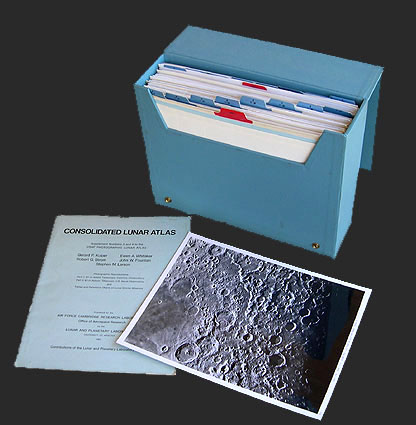August 11, 2015
CLA
Originally published August 11, 2004
Image Credit: Chuck Wood |
|
CLA The Consolidated Lunar Atlas is the best photographic lunar atlas ever. Now that might seem a contentious statement so lets consider the CLA and other pretenders to the title. The CLA consists of 228 photographic prints distributed in a 20 lb blue box in 1967. Each sheet is 11" by 14" and is excellently printed. The low sun photos were taken with the 61" Catalina telescope near Tucson, and have the same scale and uniformly high resolution, about 2 - 2.5 km. An effort was made to capture detail near terminators. A few frames of the eastern limb are from the Lick 36" and the full Moon views came from the Naval Observatory 61" in Flagstaff. Each area is shown 3-6 times with various lighting angles. Nearly 40 years after the CLA was released it remains the richest source of terrestrial images of the Moon and has been used in support of hundreds of scientific investigations. The main negative feature of the CLA is that only a few hundred copies were made and distributed to observatories and lunar scientists active at that time, so that it has been widely unavailable. That situation has now changed with the entire atlas being online and available as a CD set from the Lunar and Planetary Institute. The 19th century equivalent of the CLA was the Atlas Photographique de la Lune (the Paris Atlas) published in sections over 14 years. The lunar photos were widely reproduced (in reduced scale sets and individual photos) for a few decades. By today's standards (actually even by comparison to Mt Wilson, Lick and Yerkes photos from the 1900s-1920s) they were very grainy, and apparently not all to the same scale and haphazardley organized . Recently, a rare, complete set has been offered for $150,000! In 1960, Gerard Kuiper and colleagues published the Photographic Lunar Atlas, which was the direct ancestor of the CLA. This massive atlas was a collection of the best photos from various observatories, enlarged to a common scale and packaged as huge loose leaf sheets of halftone images in a big red box. The CLA has higher resolution images and is more convenient to use. Related Links: Yesterday's LPOD: Australian Eclipse Tomorrow's LPOD: Ptolemy's Strange Floor |
Author & Editor: |
COMMENTS?
Register, Log in, and join in the comments.




